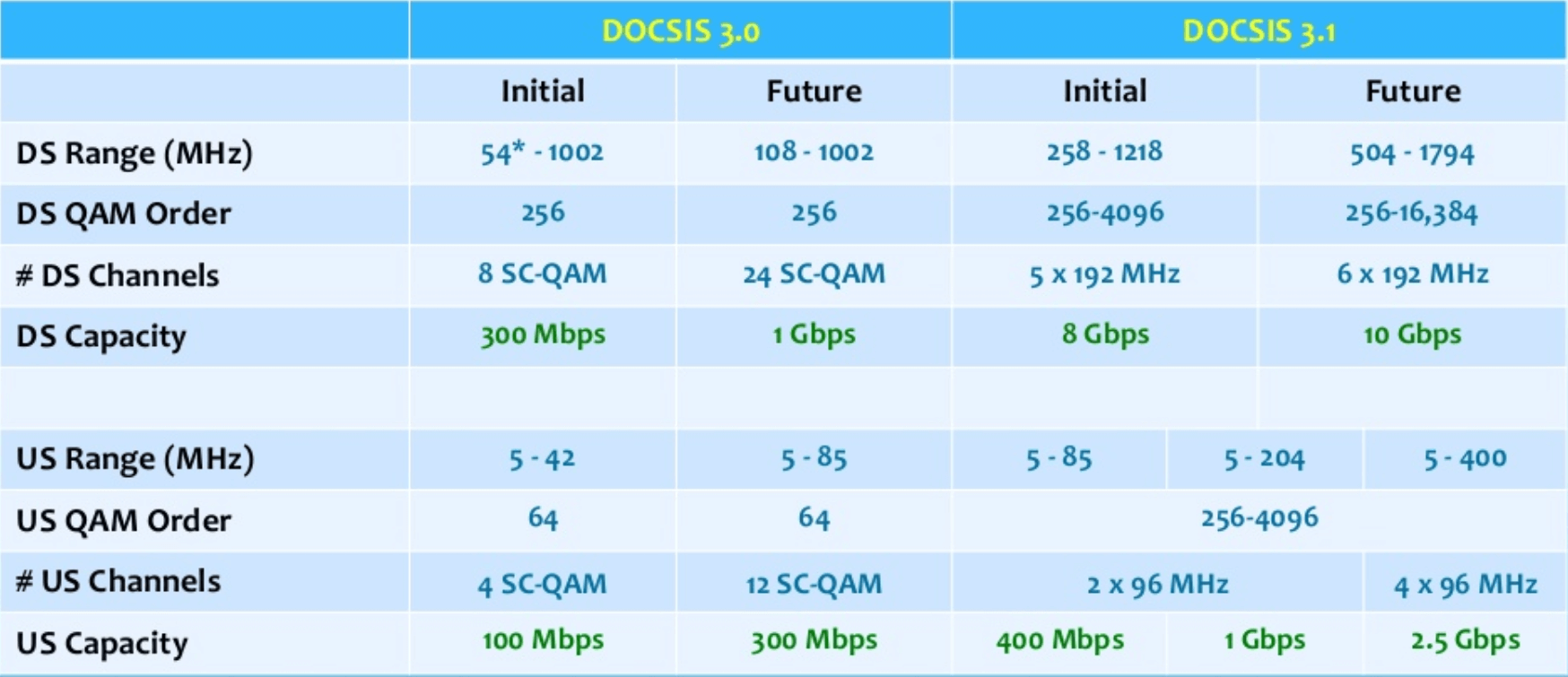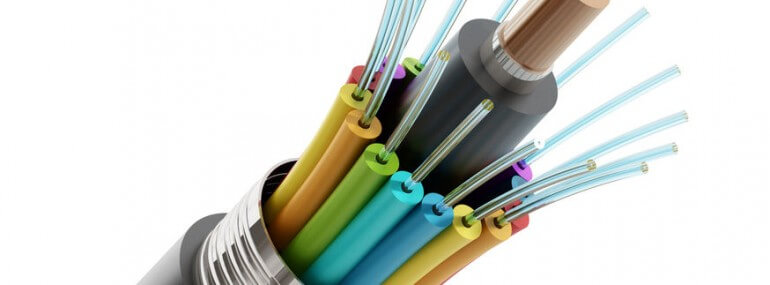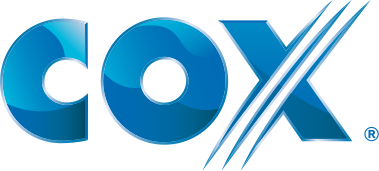What is DOCSIS 3.1?
DOCSIS 3.1 Cable Modems
DOCSIS 3.0 vs DOCSIS 3.1
Click here for comparison of DOCSIS 3.0 vs DOCSIS 3.1 technology
ISP Gigabit Plans
What is DOCSIS 3.1?
DOCSIS stands for Data Over Cable Service Interface Specification. It’s the international standard used to transfer data over cable TV systems, which makes it possible for any cable modem to work with any cable TV system.
DOCSIS 3.1 technology enables a new generation of cable services and helps operators continue to meet consumer demand for high-speed connections and sophisticated applications, positioning them to be the providers of choice in their markets.
DOCSIS 3.1 technology includes the latest and greatest of digital communication technologies such as LDPC encoding, very high modulation orders (4096 QAM for example), more than 1 GHz of usable spectrum and support of QoS and low latencies. DOCSIS 3.1 technology delivers all of this while maintaining backward compatibility to DOCSIS 3.0 technology and the ability to deploy it on today’s HFC network without any requirement to upgrade today’s plants.
DOCSIS 3.1 supports blazing speeds of up to 10 gigabits per second, a speed only remotely possible with a fiber optic connection up until this point. And because of this, fiber has been the gold standard lately when it comes to residential internet connections. This is all about to change soon, though.
Simply using a modem that supports DOCSIS 3.1 doesn’t guarantee these internet speeds, but if DOCSIS 3.1 is supported on both ends of the cable connection, it’s possible to achieve this phenomenal bandwidth, giving the best opportunity for cable providers to keep up and even rival fiber optic ISPs.
What Is DOCSIS 3.1 Capable of?
DOCSIS 3.1 now provides the very latest capabilities in digital communication technologies including
• LDPC encoding
• High modulation orders, like 4096 QAM
• More than 1 GHz of usable spectrum
• Support of QoS
• Up to 10 Gbps downstream and up to 1 Gbps upstream network capacity
In addition, DOCSIS 3.1 can be deployed on today’s HFC network, and there is also no need to substantially upgrade existing plants. While minor upgrades will be necessary, providers can begin offering immediate performance enhancements in the form of higher speeds for customers even before the minor upgrades are underway. Once those minor upgrades are complete, cable speeds will be able to match or rival fiber speeds. The process should be relatively smooth, and customers will enjoy increasingly better service during the entire process.
Greater Application and Even More Accessible
The use of Active Queue Management allows network delay to be significantly reduced with DOCSIS 3.1, even as data traffic grows on the home network. This is especially helpful in applications like online gaming where responsiveness is critical. Downloading movies and other content will be faster than ever and graphics can display at even higher resolutions.
And because cable internet is so widely available already, DOCSIS 3.1 will bring blazing fast internet speeds to more households than ever before. Something fiber has struggled to do thus far.
The Impact of DOCSIS 3.1 Technology
Deployment of DOCSIS 3.1 technology provides significant new value for cable operators and consumers of broadband services including:
- Speed
Support for up to 10 Gbps downstream and up to 1 Gbps upstream network capacity.
- QUALITY OF EXPERIENCE
Utilizes Active Queue Management to significantly reduce network delay as data traffic grows in the home network, dramatically improving responsiveness for applications such as online gaming.
- HIGHER CAPACITY ON EXISTING NETWORKS
Enables a significant increase in network capacity with the ability to transmit up to 50 percent more data over the same spectrum, on existing HFC networks.
- ENERGY EFFICIENCY
Enhancements to the DOCSIS protocols increase cable modem energy efficiency through advanced energy management protocols.
Best DOCSIS 3.1 Cable Modem Comparison
DOCSIS 3.0 vs DOCSIS 3.1

FAQs
- Do I need DOCSIS 3.1 Cable Modem for Gigabit service?
While DOCSIS 3.0 can support Gigabit speeds in lab environment as a single user, DOCSIS 3.1 modems with OFDM technology is required for Gigabit service for almost every ISP in US
- What is the cost of DOCSIS 3.1 Gigabit Modems
Most DOCSIS 3.1 Cable Modems are in $150-200 Range (Modem Only) and will get cheaper as there are more competitors coming in market
- Is it a good time to purchase a DOCSIS 3.1 Modem?
2019 is very good time to purchase a DOCSIS 3.1 modem. These modems will last you at least few years for Internet needs
- Should I buy DOCSIS 3.1 modem for lower ISP speed packages?
Yes, Preferably if you can afford it. If you have 250 Mbps and above service, DOCSIS 3.1 will improve speeds, signal levels and reliability
- Why is DOCSIS 3.1 better than DOCSIS 3.0 technology?
DOCSIS 3.1 technology improves the spectral efficiency of the HFC network and thus increases the capacity significantly. While DOCSIS 3.0 technology supports up to 256 QAM (8 bits/symbol), DOCSIS 3.1 technology supports up to 4096 QAM (12 bits/symbol) thus providing the potential to drastically increase the system capacity.
- Do you need to deploy DOCSIS 3.1 technology in the upstream and downstream simultaneously?
No, DOCSIS 3.1 technology is backwards compatible to DOCSIS 3.0 technology. A DOCSIS 3.1 downstream can operate with a DOCSIS 3.0 upstream and a DOCSIS 3.1 upstream can operate with a DOCSIS 3.0 downstream channel.
- Do you need to upgrade the cable plant to deploy DOCSIS 3.1 technology?
No, DOCSIS 3.1 technology does not require any upgrades to the HFC plant in order to operate. DOCSIS 3.1 technology can capitalize on HFC network upgrades to increase network capacity.
- Do you need to expand the upstream to deploy gigabit service in the downstream channel?
The current 5-42 MHz upstream channel provides sufficient capacity to deploy gigabit services in the downstream.
- Could you deploy DOCSIS 3.1 technology in the existing plant, and then reduce the downstream service group size and/or expand the downstream/upstream spectrum capacity?
DOCSIS 3.1 technology can be deployed on the current HFC network with any required modifications. DOCSIS 3.1 technology provides great flexibility in defining the channel spectrum and the group sizes.
- Will DOCSIS 3.1 modems run in DOCSIS 3.0 systems?
Yes, DOCSIS 3.1 devices are backwards compatible and will operate on a DOCSIS 3.0 system.
- Will DOCSIS 3.1 modems require dedicated spectrum?
DOCSIS 3.1 downstream channel will require dedicated spectrum to operate, while the DOCSIS 3.1 devices can share the upstream spectrum with DOCSIS 3.0 devices.
- Will DOCSIS 3.0 modems need to be upgraded when DOCSIS 3.1 technology is deployed?
DOCSIS 3.1 technology is backwards compatible to DOCSIS 3.0 technology; thus DOCSIS 3.0 devices will not need to be upgraded when DOCSIS 3.1 technology is deployed.
- How does DOCSIS 3.1 technology compare with FTTH?
DOCSIS 3.1 technology was designed to support multiple Gbps of line capacity while maintaining economical deployment and maintenance costs on the current HFC infrastructure, thus delivering Gbps performance to the masses in contrast to the limited deployment of FTTH solutions.





